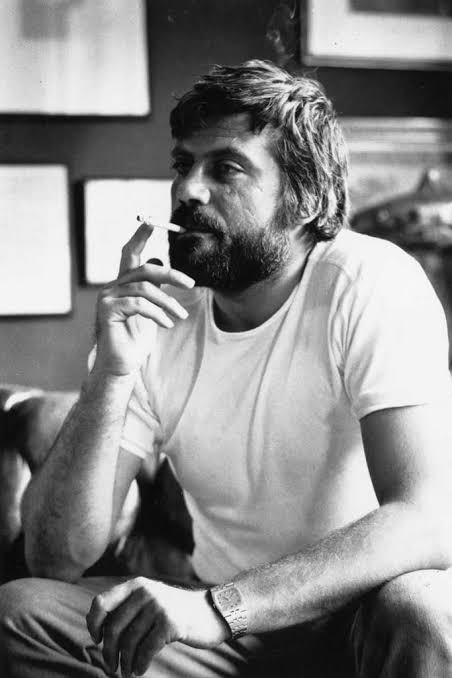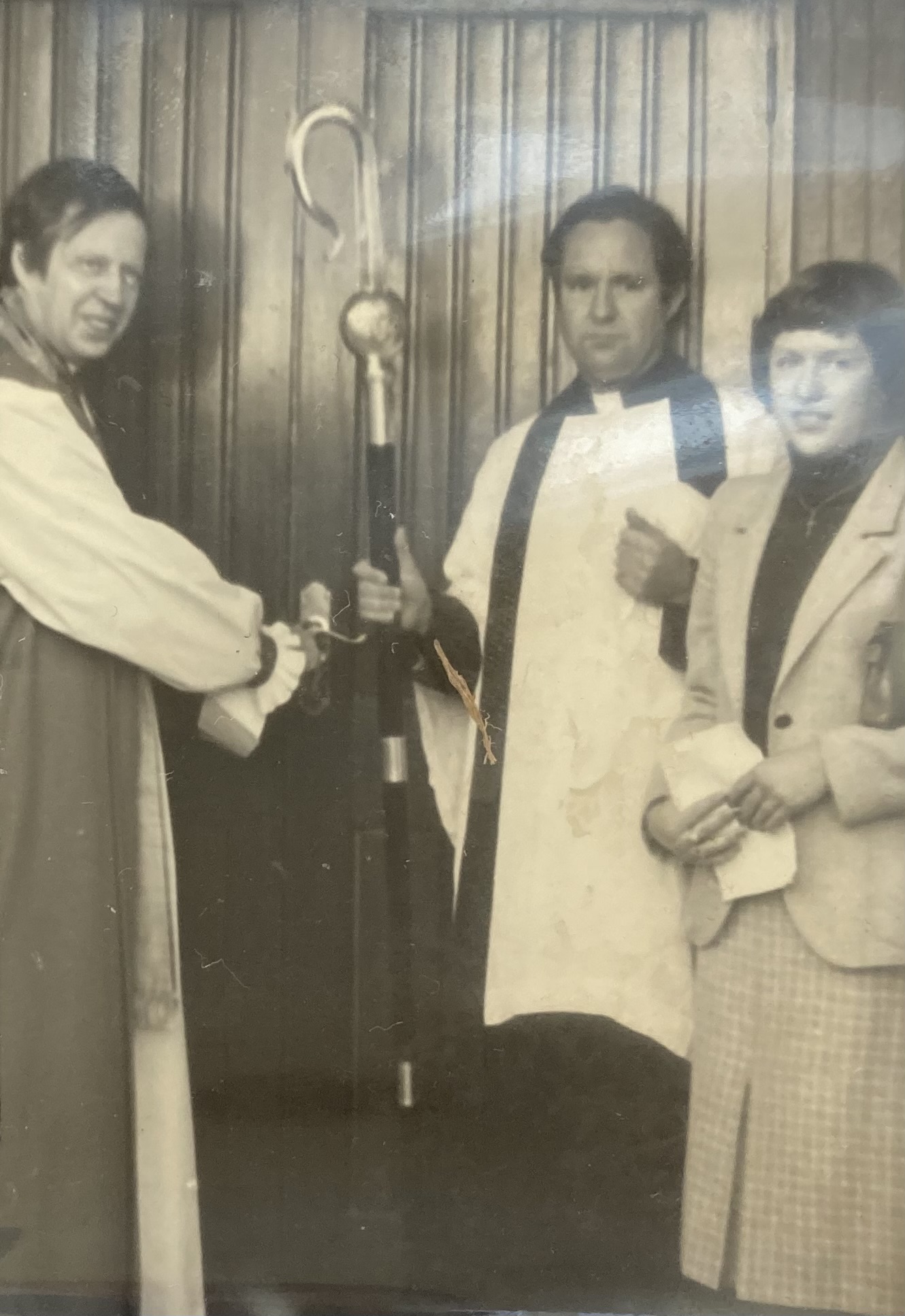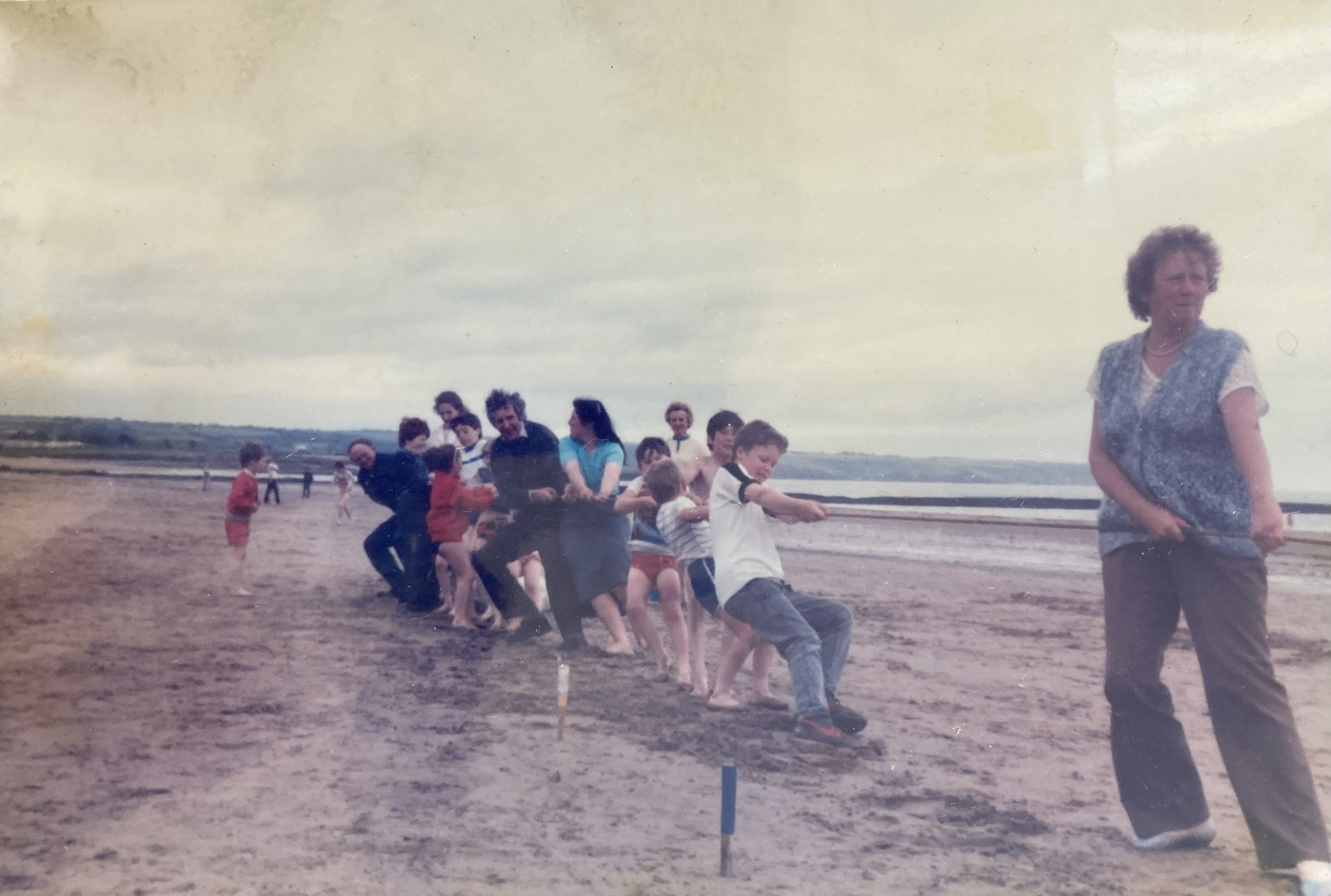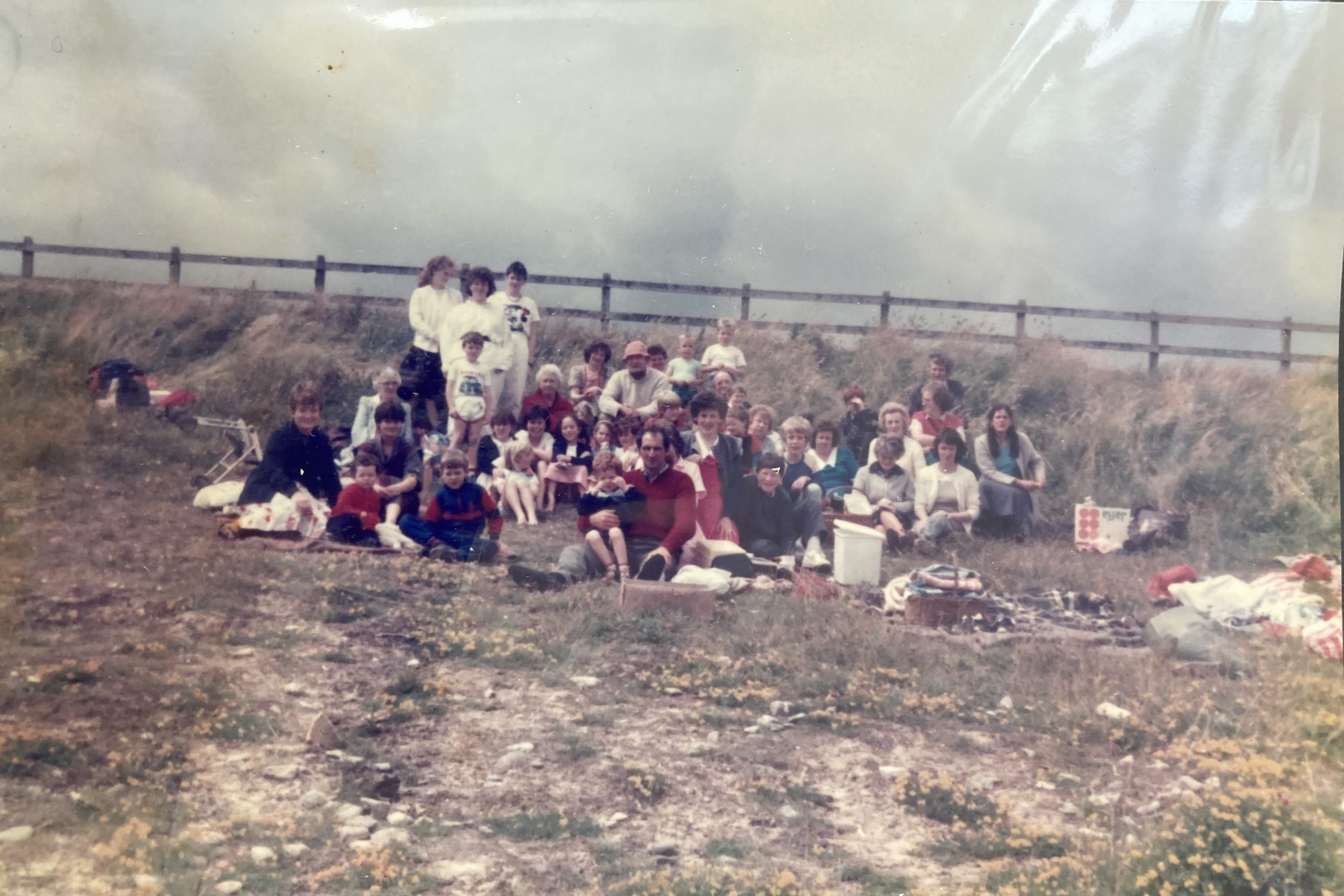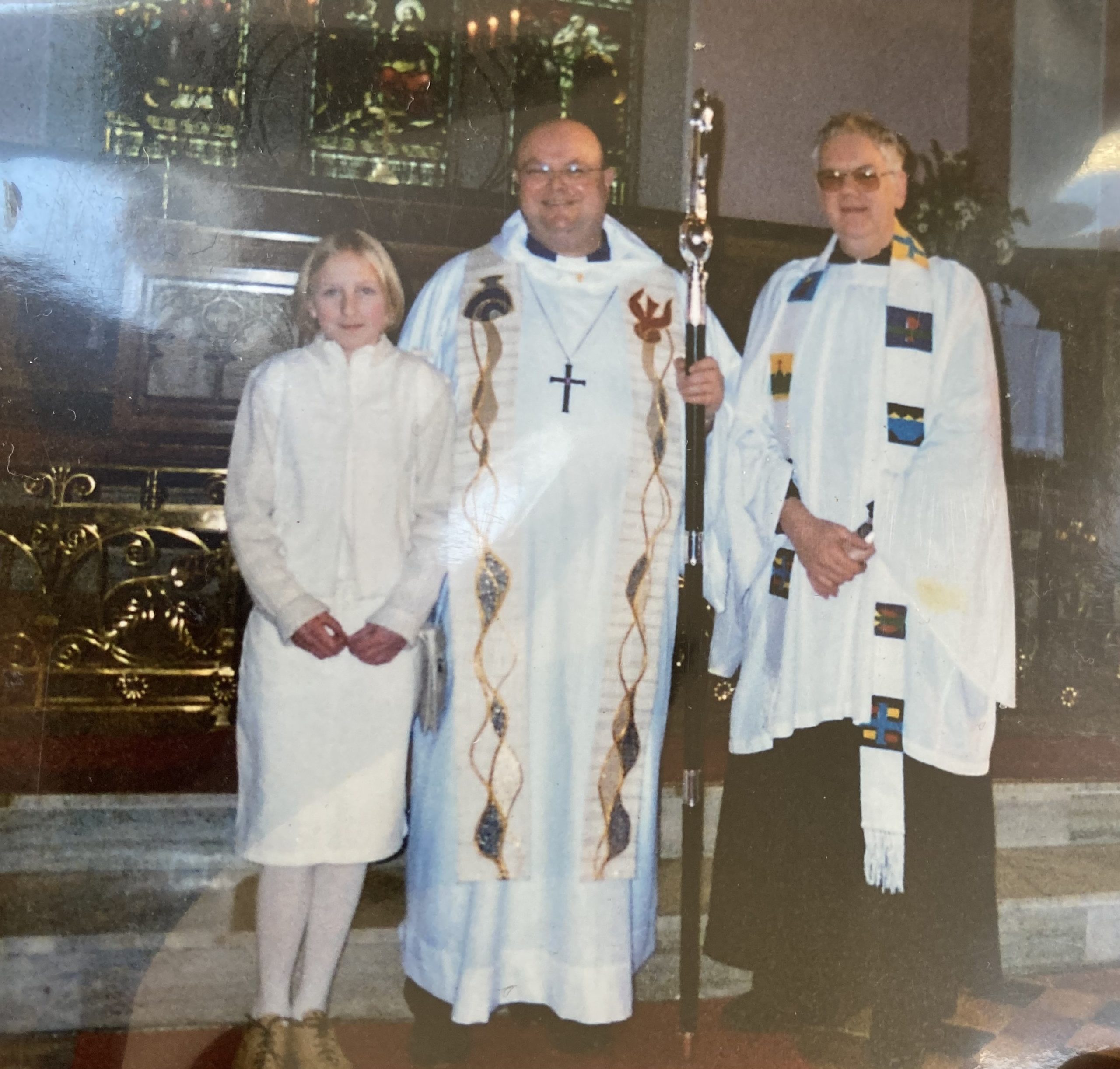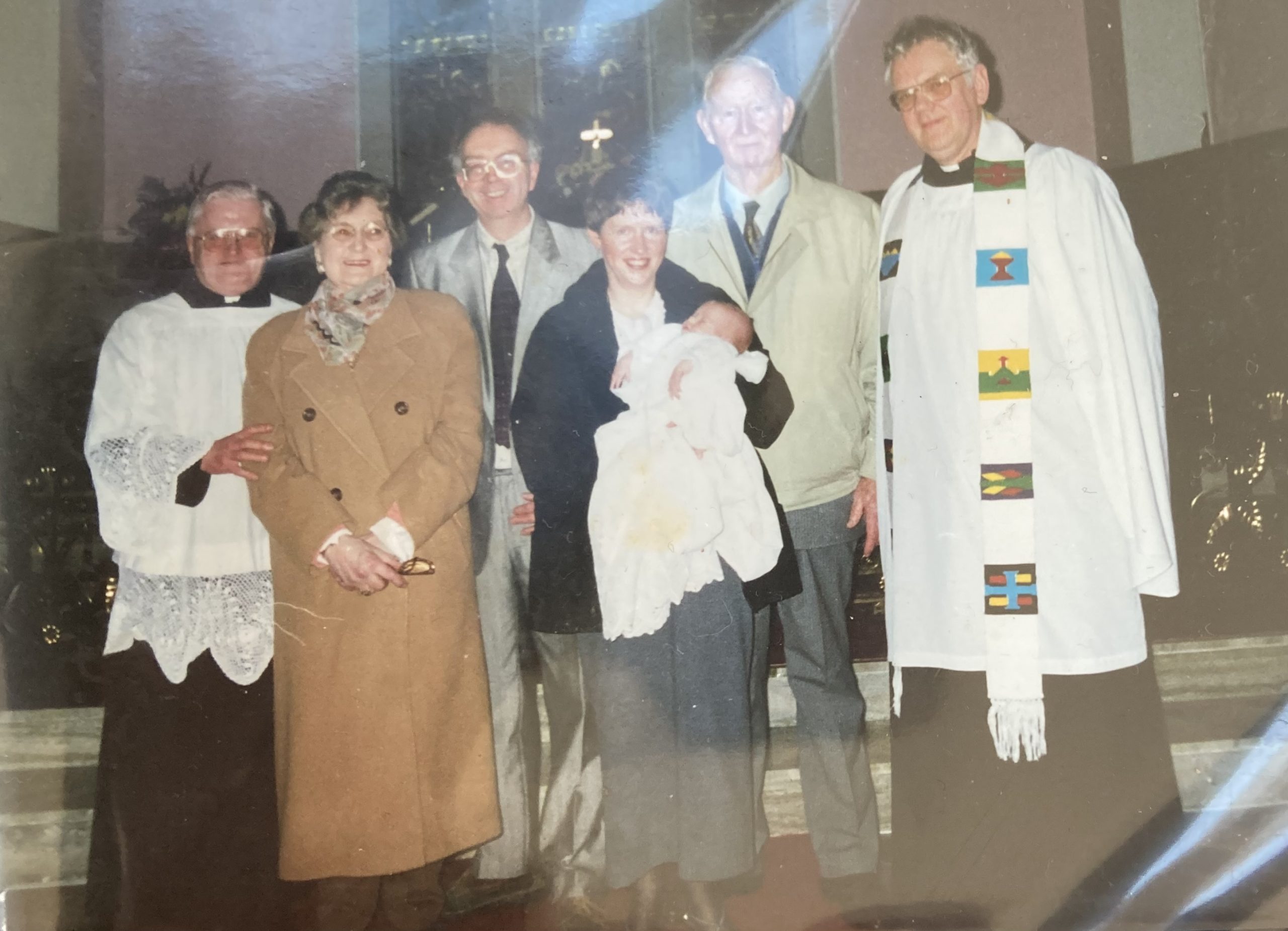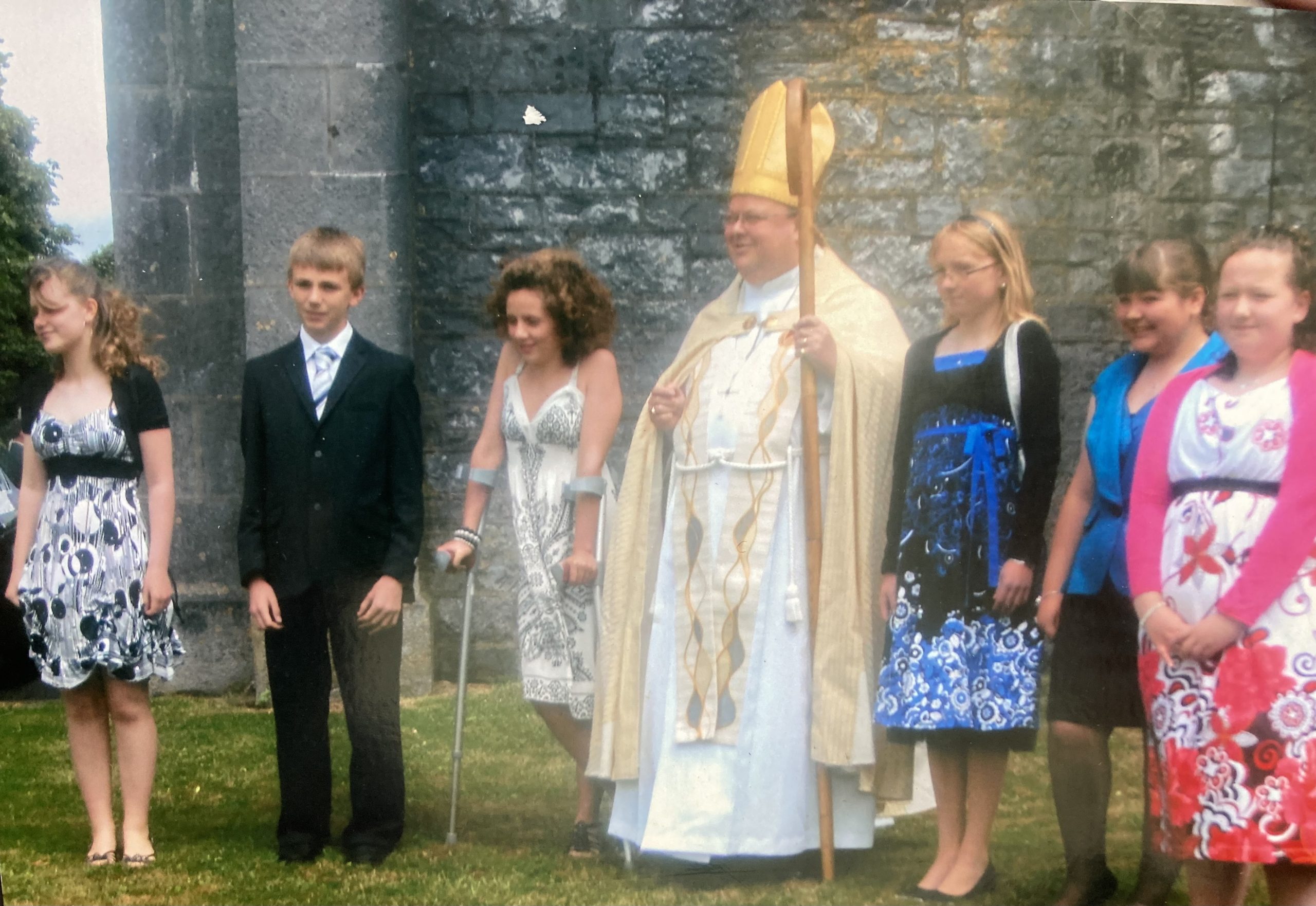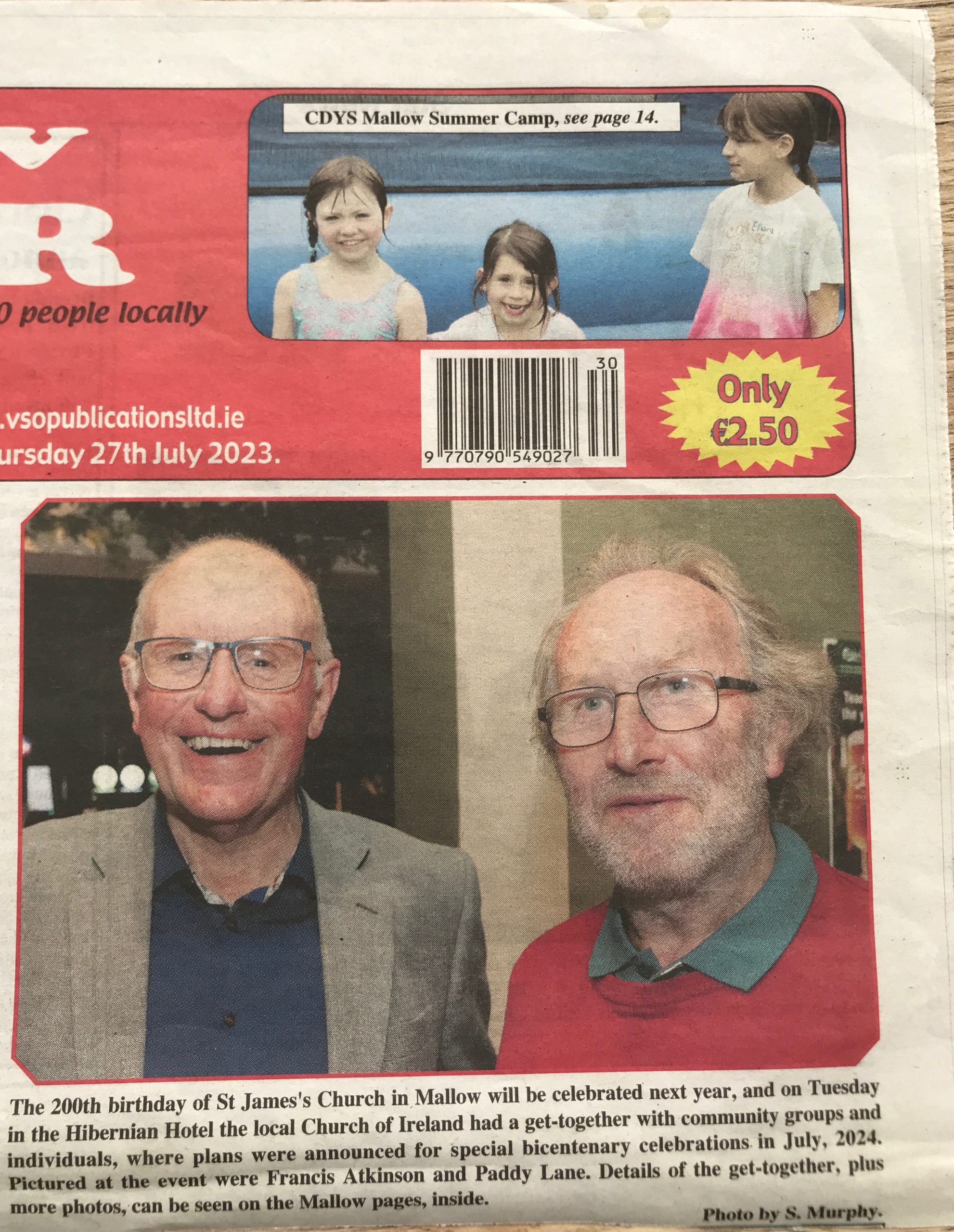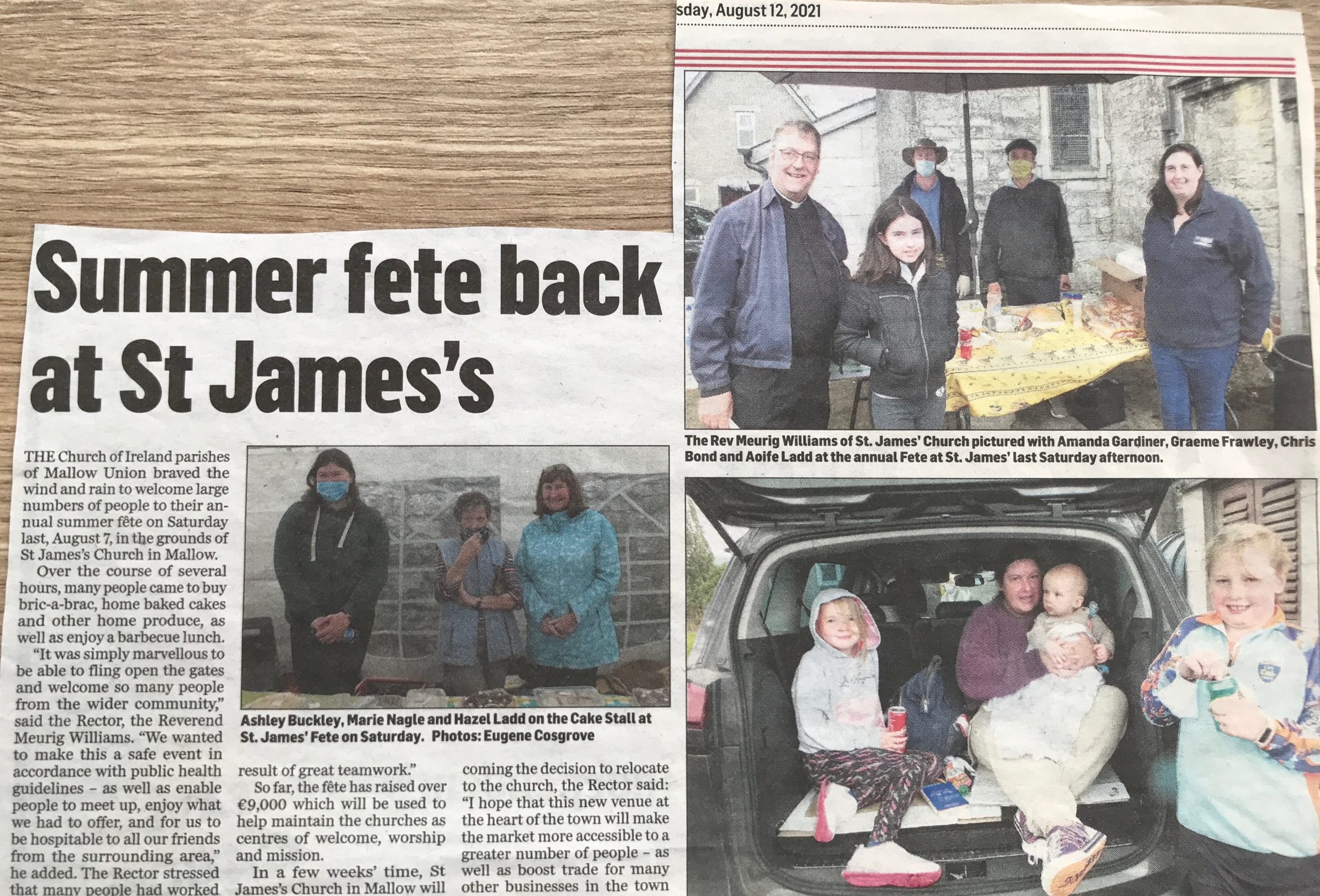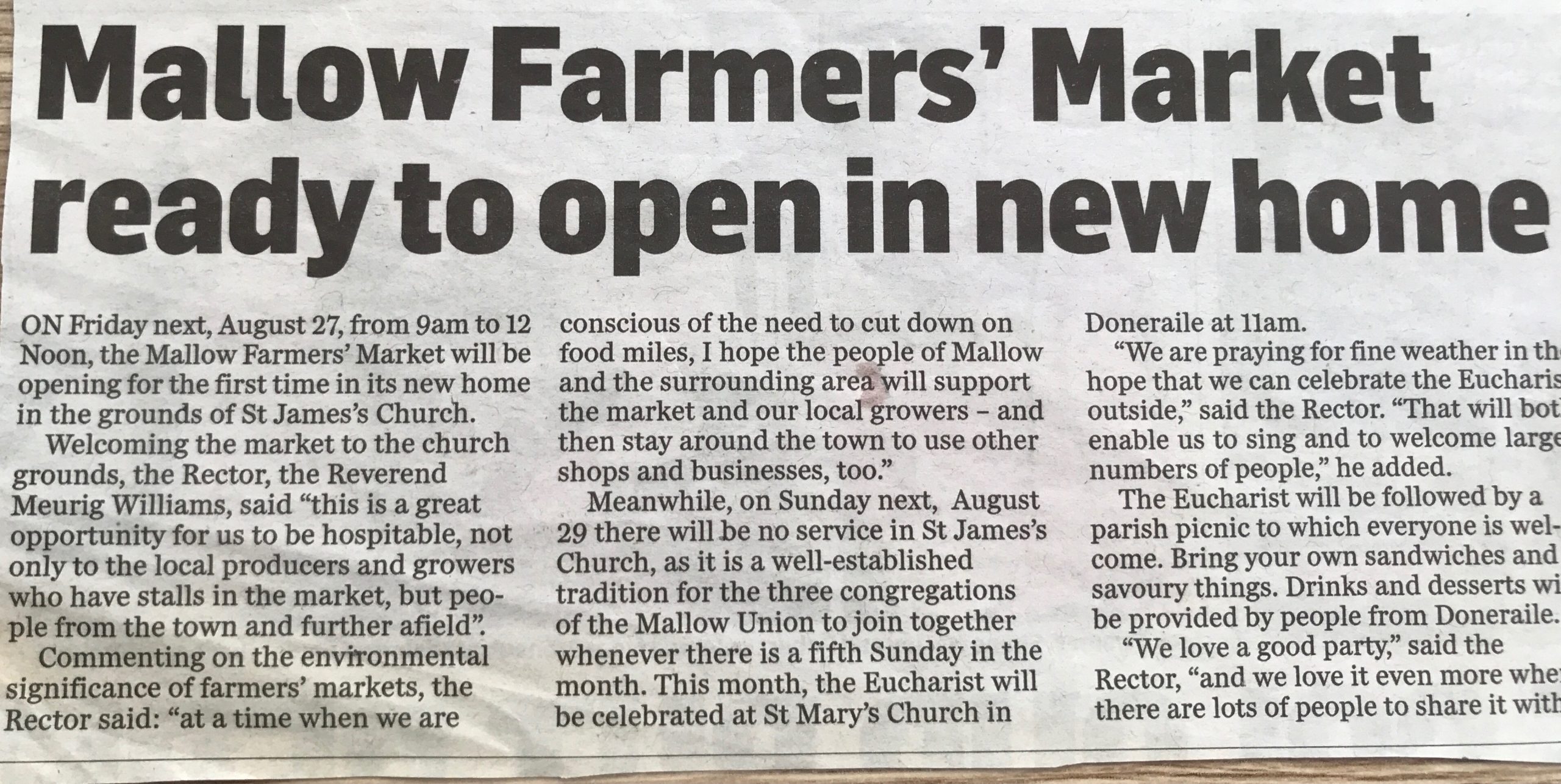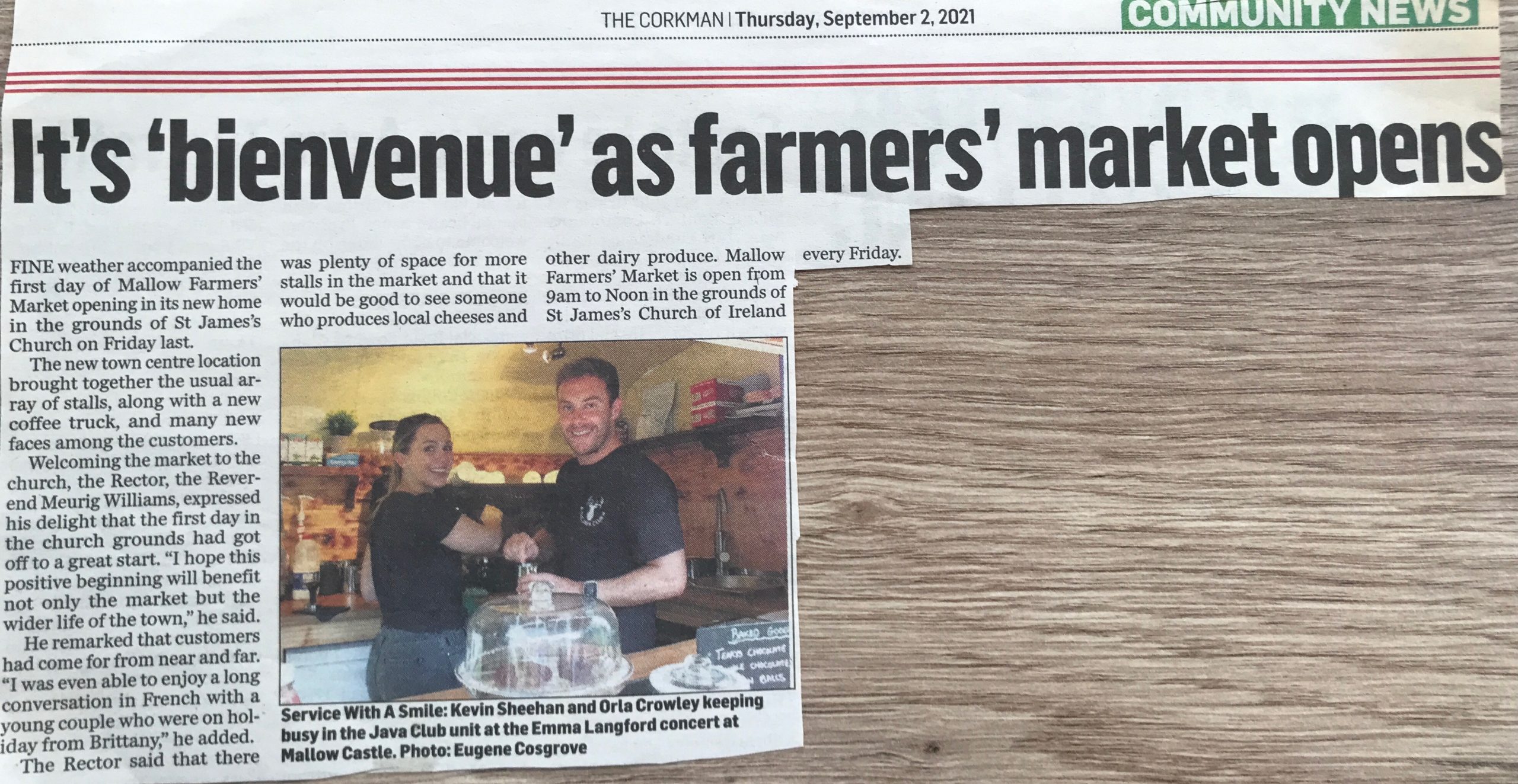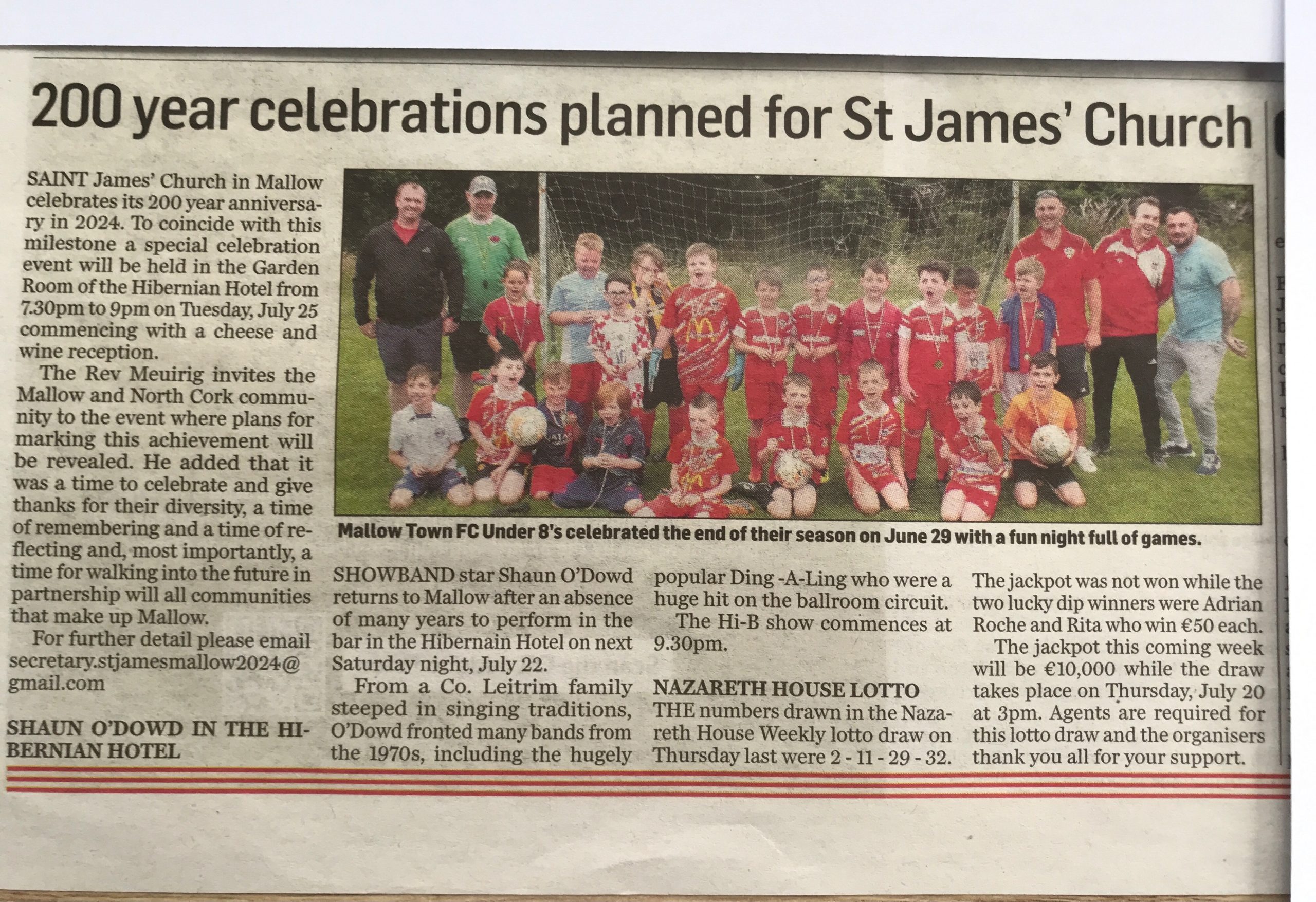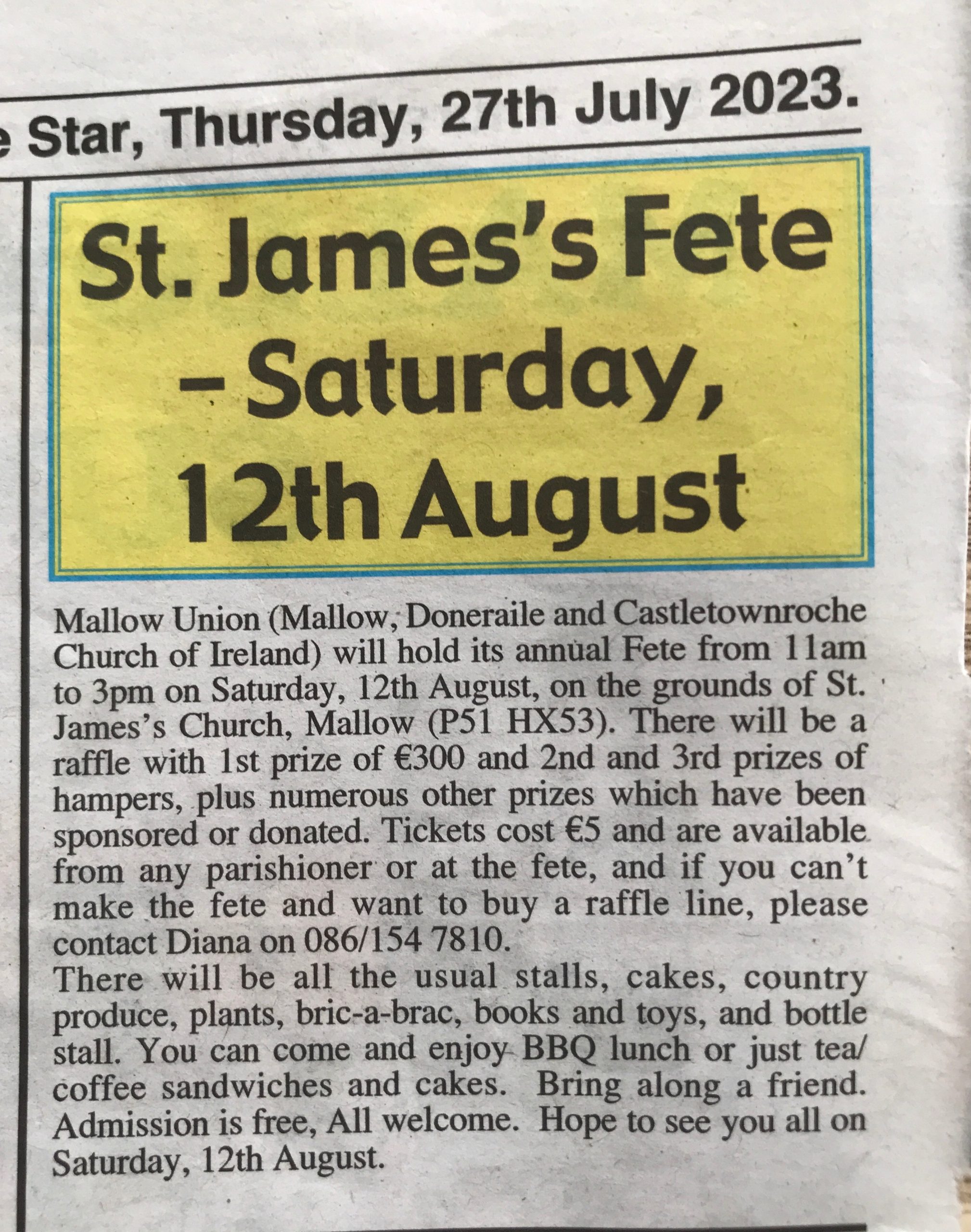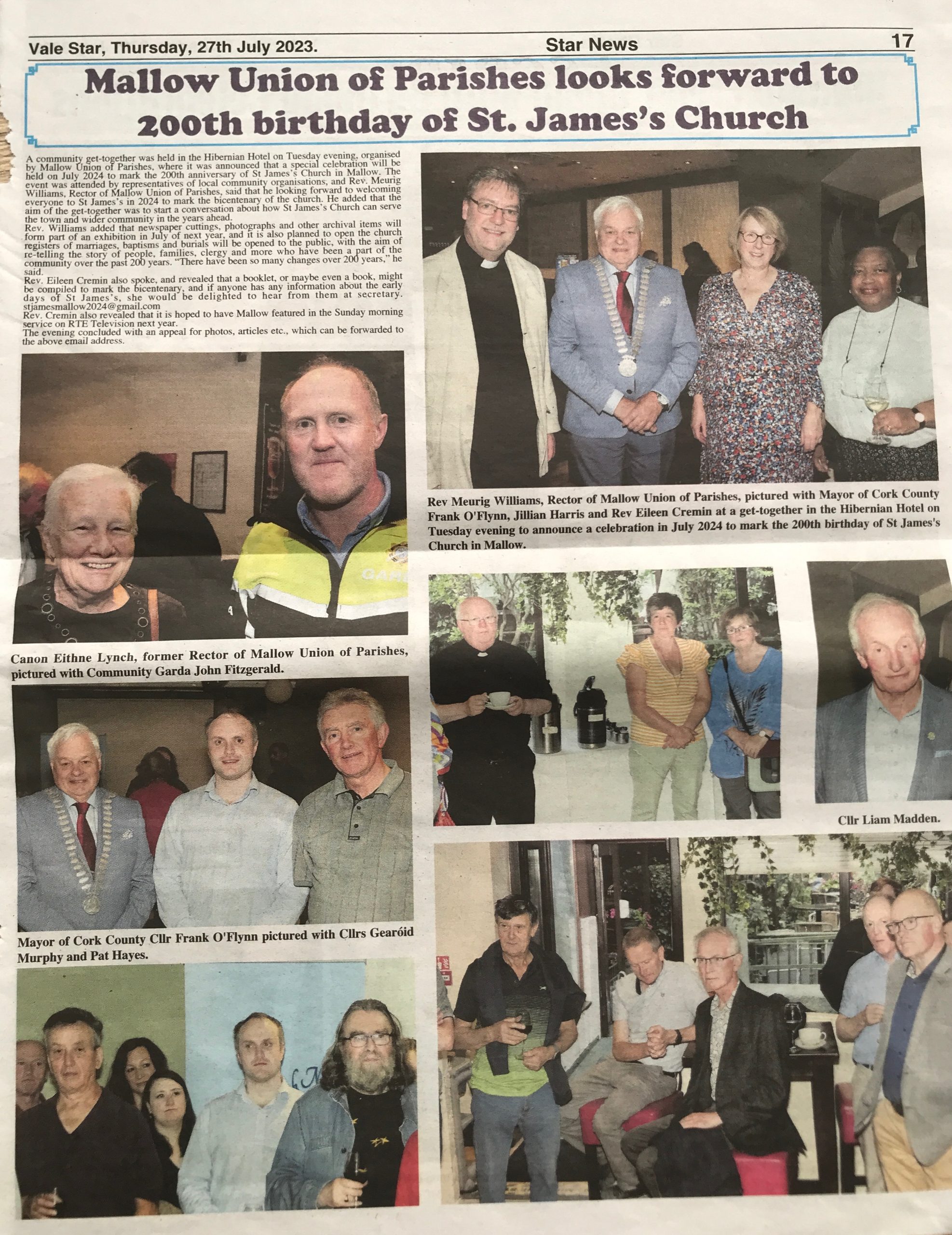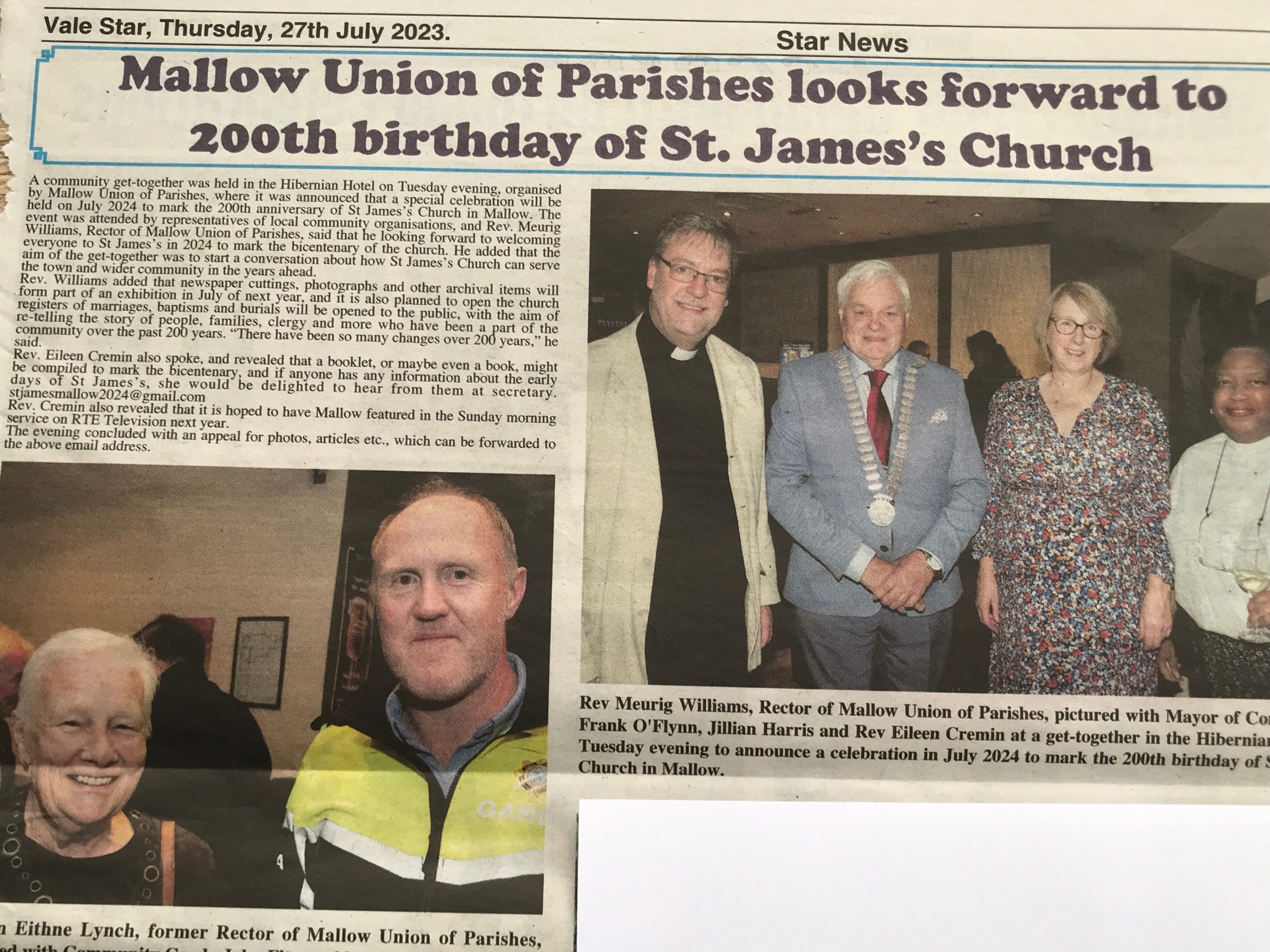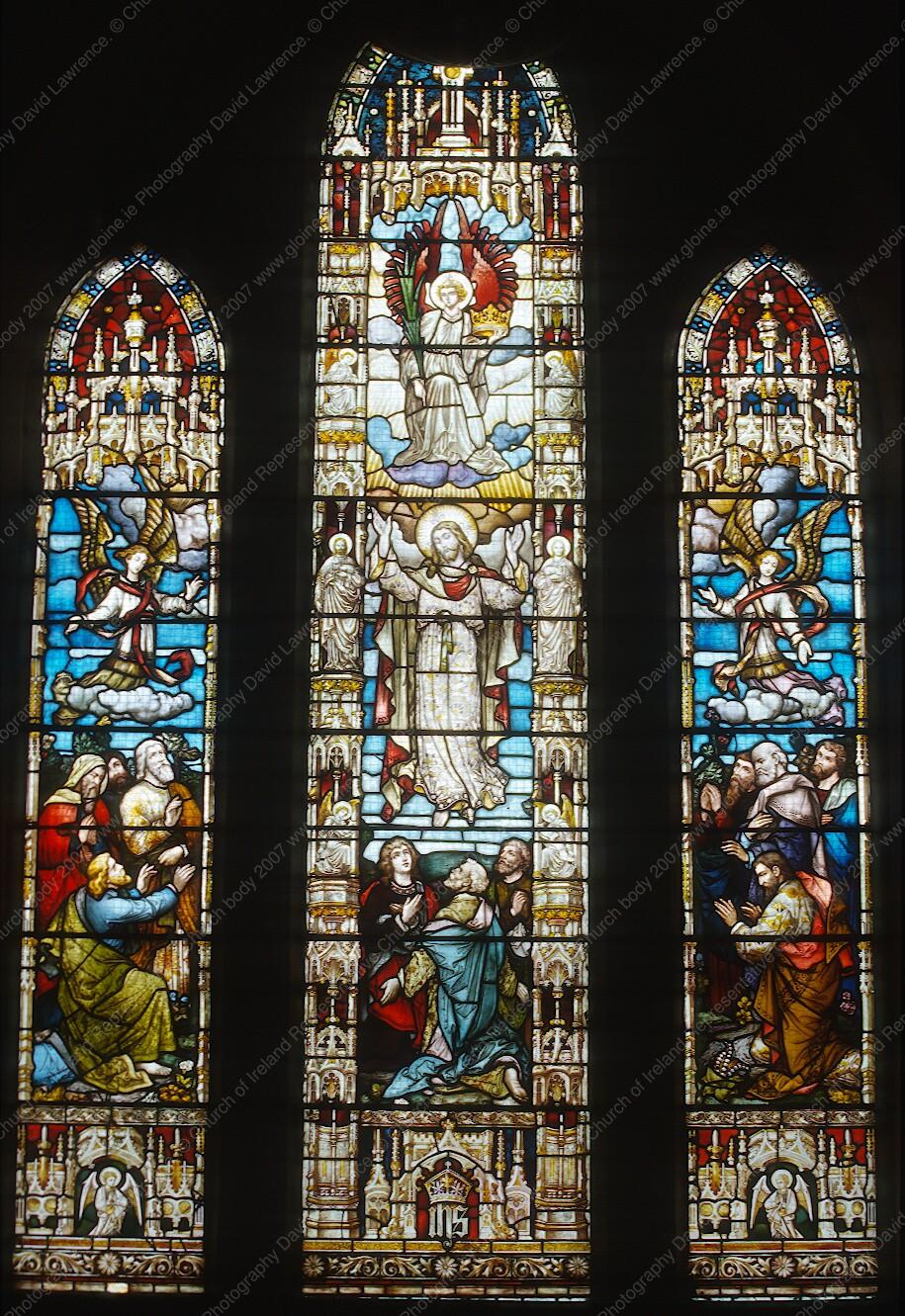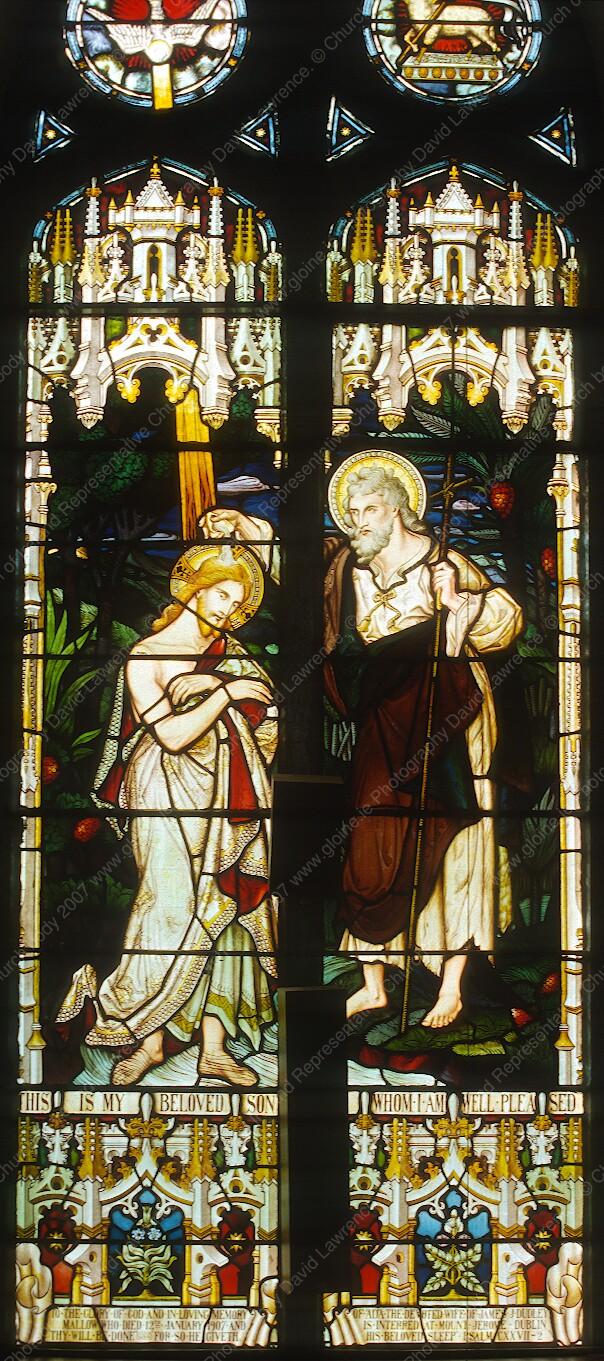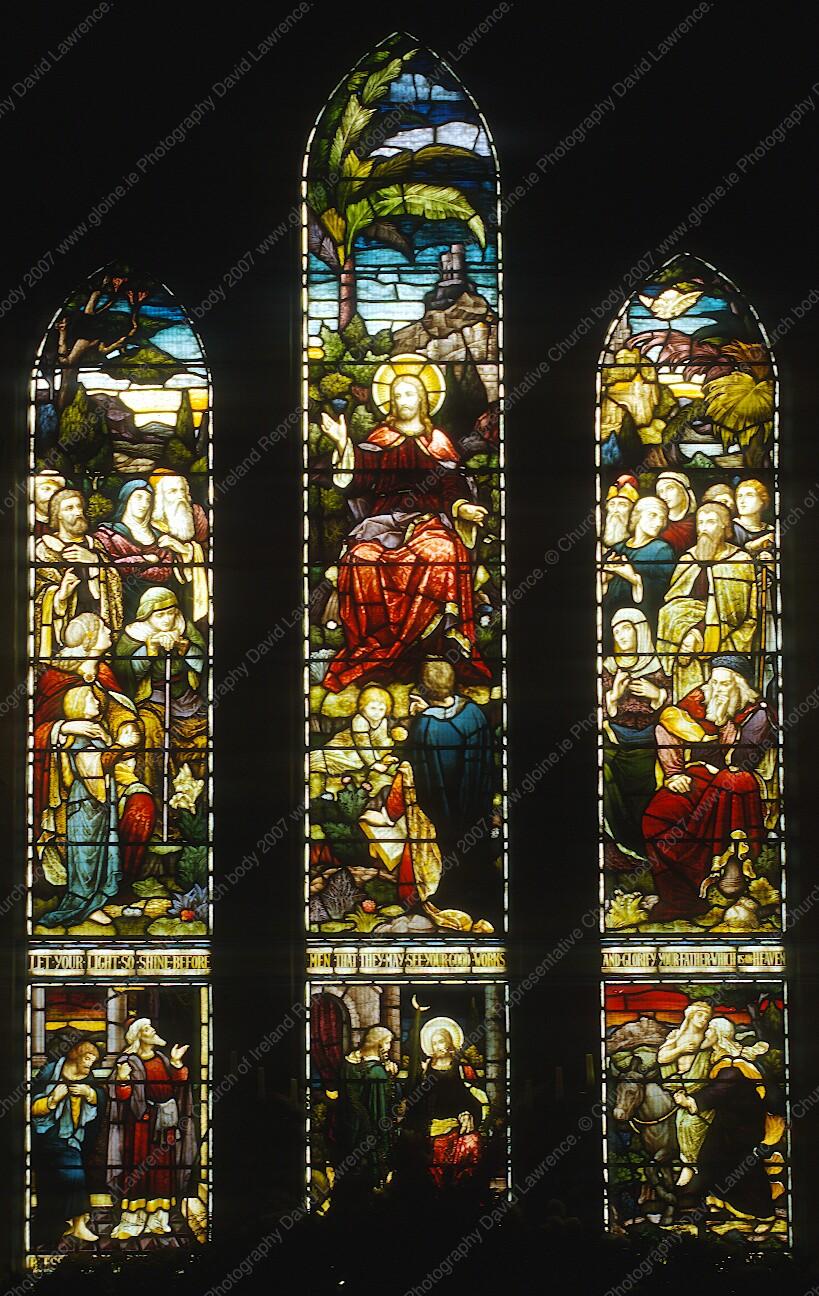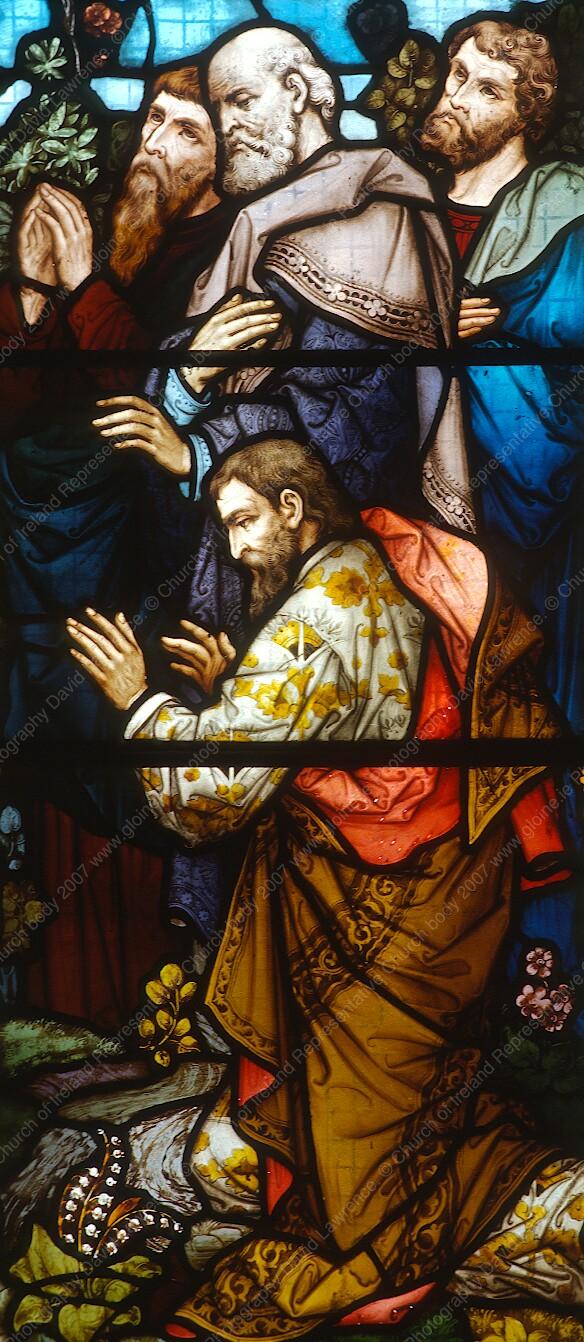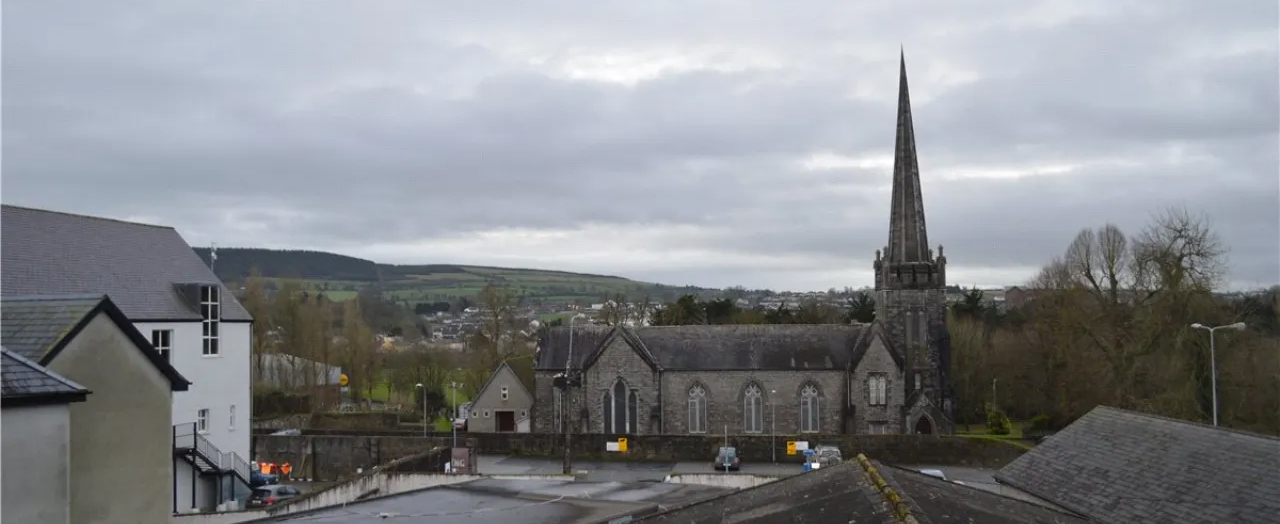

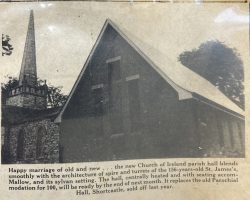
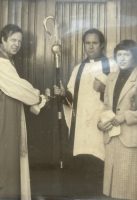

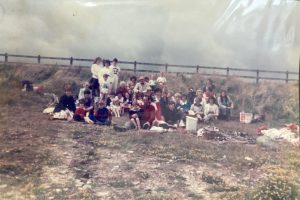
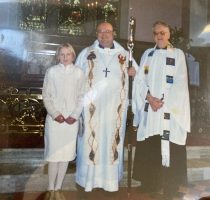
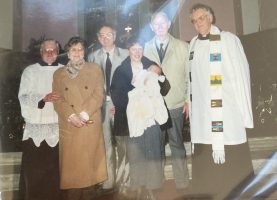
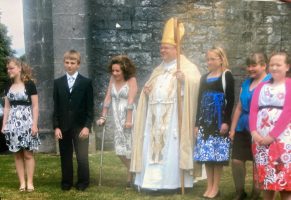

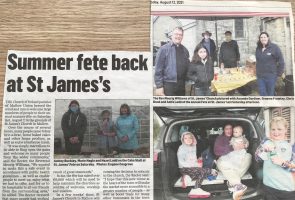
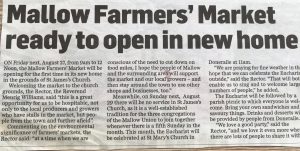

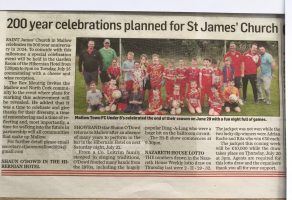
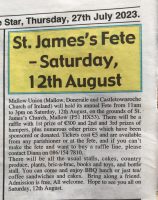

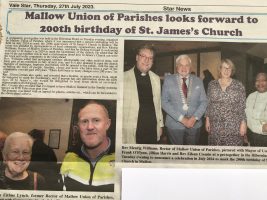
St James’ Church was consecrated in 1824 which means it will be 200 years old in 2024. St James’s replaced an earlier church dedicated to St Anne. The shell of this building still stands to the East of the present church
Situated as it is, just off the main thoroughfare overlooking the town park and river blackwater, Mallow’s Church of Ireland, St James’ Church is a typical example of an early 19th century building. The Gothic design is of limestone construction with cut stone buttressed corners, and pointed arched doors and windows. A feature of churches designed by Pain Brothers and of churches in general built around that time was the importance placed on the entrance gateway which was usually designed to complement the building therein. In this regard St. James was no exception. The cut limestone piers and impressive iron gates were originally on the Main Street but were re-located to their present position by the Urban Council in 1983. Its impressive square tower and ribbed spire is a focal point over a wide area. Though not in the more usual cruciform design its regular shape is nevertheless an imposing structure. Internally the Gothic style is evident. Its pointed arched roof structure and stained glass windows dominate.
Rev. Nicholas Wrixon was the first Rector of St. James and had been Rector of St. Anne’s since 1808, and the Churchwardens were John Gardiner and Richard Barrett.
Rectors of Mallow since 1298
| 1298 | Geoffrey Le Hore |
| 1301 | Henry Thrapeston |
| 1376 | Richard Caveton (Prior of Bridgetown) |
| 1391 | (The Church at Mallow pertains to the College at Youghal) – Records lost |
| 1615 | George Bradford |
| 1634 | Thomas Fisher |
| 1655 | Thomas Pierce) |
| 1656 | John Mascall ) Dissenting Ministers Intruded by Cromwell |
| 1658 | John Norcott ) |
| 1661 | John Norcott |
| 1663 | Thomas Sesson |
| 1667 | James Cox |
| 1687 | John Balkeley |
| 1692 | (The old Church (St Anne’s) rebuilt after the Williamite War) |
| 1702 | Henry Maule (became Bishop of Cloyne – 1726; Dromore – 1731; Meath – 1744-51 |
| 1720 | Simon Gibbings |
| 1721 | George Chinney MA |
| 1745 | Norris Jephson BA |
| 1764 | Edmund Lombard |
| 1772 | James Mackler, LLB. (became Archdeacon at Cloyne) |
| 1779 | William King MA |
| 1808 | Nicholas Wrixon |
| 1824 | (Present church built for £3,415) |
| 1828 | Sackville Robert Hamilton |
| 1853 | Allen Robert Cliffe |
| 1873 | Robert Cooper Wills MA (Archdeacon of Cloyne 1890) |
| 1872 | United with Rahan |
| 1873 | United with Mourne Abbey |
| 1882 | United with Carrigarnleary |
| 1909 | William Edward Flewett MA BD (became Archdeacon of Cork & Bishop of Cork, Cloyne & Ross) |
| 1913 | Samuel HP Harman MA (Canon of Cloyne) |
| 1940 | Claude Lionel Chevasse MA B.Litt. |
| 1944 | Arthur Reginald Nash MA L.T.H |
| 1950 | Robert Harris Bryan MA |
| 1955 | Frederick Henry Garrett BA |
| 1975 | Joseph J Perrott |
| 1978 | Nicholas Marshal Cummins |
| 1983 | Charles C. Ruddock D.B.S. |
| 1992 | Anthony G.S Whiting |
| 1998 | Robert G Kingston T.C.D. |
| 2008 | Denis F A MacCarthy BD. |
| 2010 | Eithne E M Lynch B.Th. (Canon of Cork, Cloyne & Ross) |
Stained Glass Windows in St James’


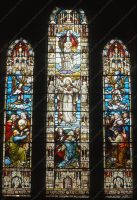

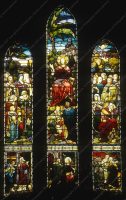

Images + info from: https://www.gloine.ie/ Project by the Church of Ireland
Notable personalities associated with St James’ across the years
Arthur Jermy Mounteney Jephson (known by his African nickname as Bubarika Sonao MBele)
He was a colleague of the world famous explorer Sir Henry Morton Stanley. A Welshman, Stanley (born 1841) led several expedition expeditions in search of another famous explorer, Dr. Livingstone, and from which originated the famous exclamation “Dr. Livingstone I presume.”
On Sir Stanley’s last trip to Africa in 1887 in which it was intended to rescue Emin Pasha (born Edward Schnitzer in 1840) a German explorer who had been cut off from civilization by a native uprising, Stanley was accompanied (with others) by A.J. Mounteney Jephson, who, though born in Essex was of the Mallow Jephsons. The mission was successful and Emin Pasha was rescued in 1888.
(Arthur Desmond Mounteney Jephson-Norreys was a son of the explorer and was killed in an underground railway accident in
London in 1938).
Arthur Jermy Mounteney Jephson (1859-1908)
(African nickname – Bubarika)
Photo from the Isabella Stewart Gardner Museum Boston MA
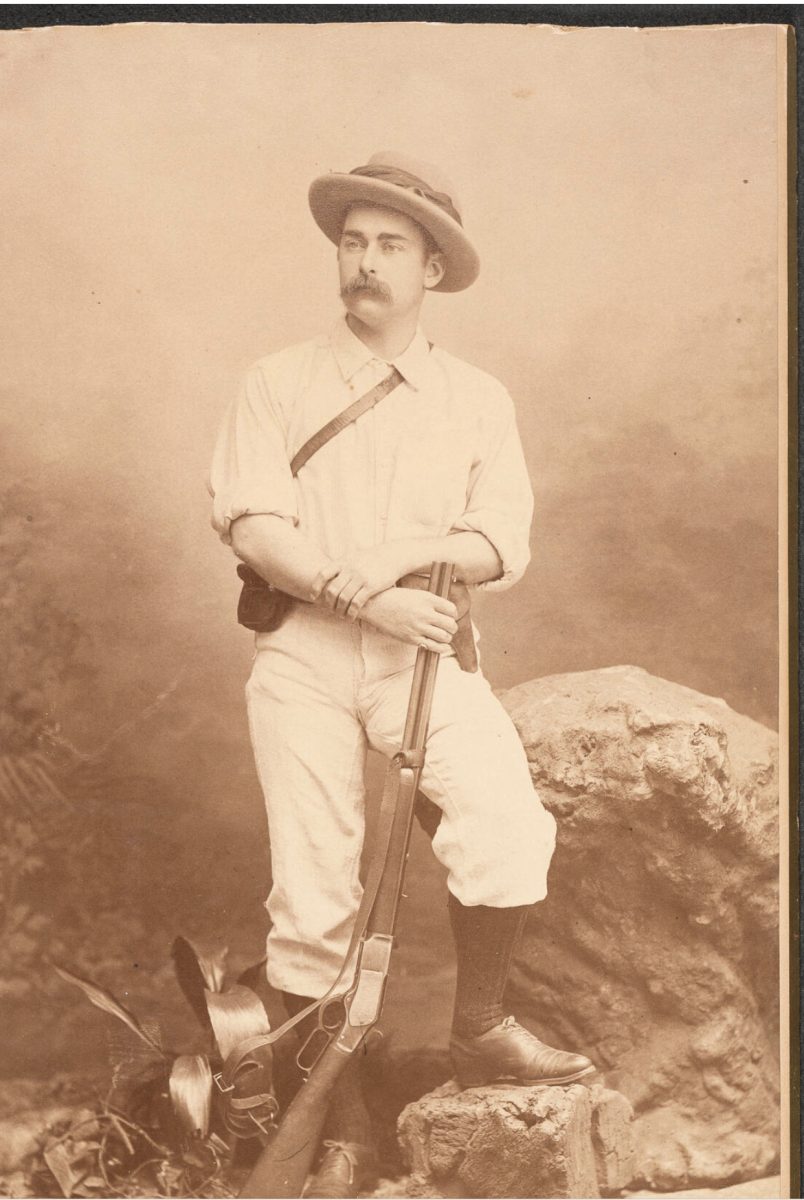
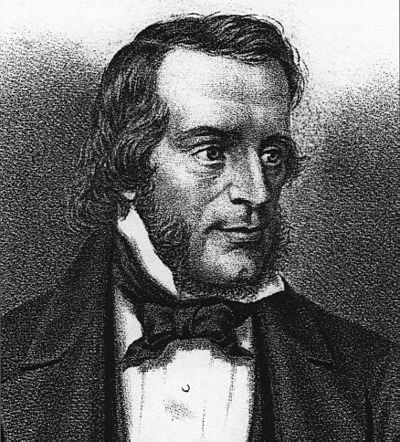
Thomas Osborne Davis (1814-1845)
He was baptised in St Anne’s Church in 1814. The Irish writer was among the founders of the Young Ireland movement in the 19th century, whose influential publication was the weekly paper “The Nation”. He believed in the love of country, the power of music and the study of Gaelic civilisation to bring about an Irish cultural identity separate from that of Britain. He is the composer of such famous ballads as “The West’s Asleep” and “A Nation Once Again” As a Protestant Davis preached religious unity, the common (mixed) education of Catholics and Protestants and advocating for Irish as the national language. In 2014 on a visit to Mallow to mark the bicentenary of Thomas Davis’ birth the President of Ireland, Michael D. Higgins planted a tree in St James’ Churchyard as part of the commemorations.
A statue of Thomas David stands at the Davis Street/ Clockhouse junction in Mallow.
Oliver Reed (1938-1999)
After a turbulent life and career in the spotlight Oliver Reed lived out his latter years in Churchtown Co. Cork. His funeral service was held in St. James’ Mallow. The Rev Robert Kingston told the congregation that Reed’s cup had overflowed in many ways, not least in terms of talent. Everyone, he said, would have to drink wine in Heaven eventually. Oliver Reed was buried in Bruhenny Graveyard, Churchtown.
